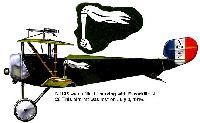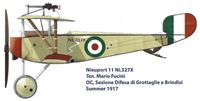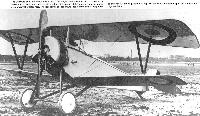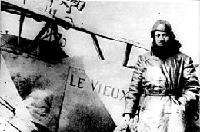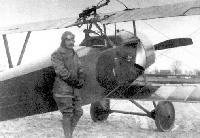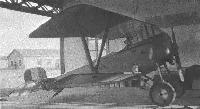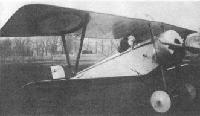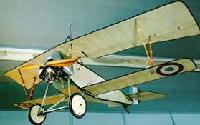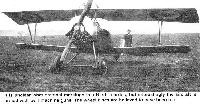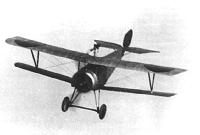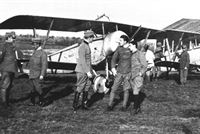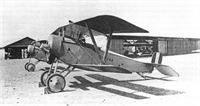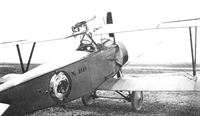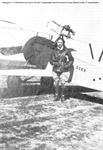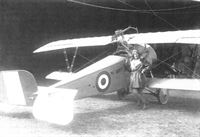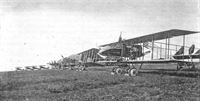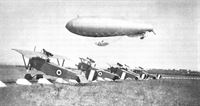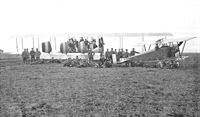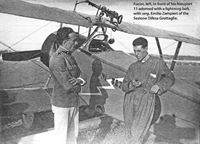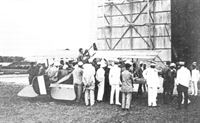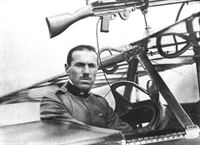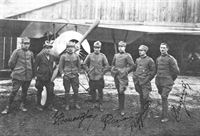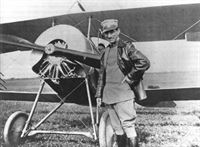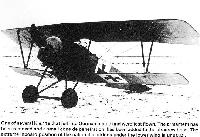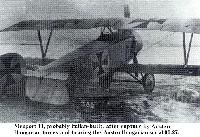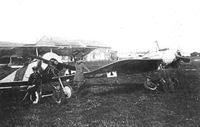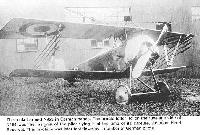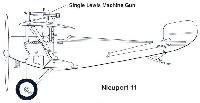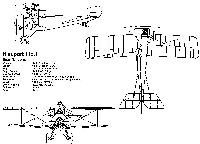
Описание
Страна: Франция
Год: 1915
Истребитель
Варианты
- Nieuport - Nieuport-11/16 Bebe - 1915 - Франция
- Nieuport - Nieuport-17/21/23 - 1916 - Франция
- Siemens-Schuckert - D.I - 1916 - Германия
- Nieuport - Nieuport-17bis/24/27 - 1917 - Франция
- В.Кондратьев Самолеты первой мировой войны
- А.Шепс Самолеты Первой мировой войны. Страны Антанты
- В.Шавров История конструкций самолетов в СССР до 1938 г.
- J.Davilla, A.Soltan French Aircraft of the First World War (Flying Machines)
- W.Green, G.Swanborough The Complete Book of Fighters
- O.Thetford British Naval Aircraft since 1912 (Putnam)
- H.Nowarra, G.Duval Russian Civil and Military Aircraft 1884-1969
- A.Durkota, T.Darcey, V.Kulikov The Imperial Russian Air Service (Flying Machines)
- E.Hauke, W.Schroeder, B.Totschinger Die Flugzeuge der k.u.k. Luftfahrtruppe und Seeflieger 1914-1918
- J.Davilla Italian Aviation in the First World War. Vol.3: Aircraft M-W (A Centennial Perspective on Great War Airplanes 75)
-
J.Davilla, A.Soltan - French Aircraft of the First World War /Flying Machines/
Nieuport 11 of N 12
-
В.Кондратьев - Самолеты первой мировой войны
Ньюпор 11, эскадрилья N-67, пилот - су-лейтенант Ж.Наварр, 1916г.
-
J.Bruce - Nieuport Fighters /Albatros/
NIEUPORT 11, N.576, Sous Lt. J Navarre, Escadrille N.67, 1916.
Finished in clear-doped fabric or pale yellow overall with natural metal cowling and cheek fairings. All surfaces outlined in an undefined colour, French roundels in six positions with white areas of upper wing markings apparently omitted. Fuselage and wheel decor emphasises the nationality of both machine and pilot. -
А.Шепс - Самолеты Первой мировой войны. Страны Антанты
Истребитель "Ньюпор-11" французских ВВС (1915г.)
-
А.Шепс - Самолеты Первой мировой войны. Страны Антанты
"Ньюпор-11" с новым капотом и коком винта
-
А.Шепс - Самолеты Первой мировой войны. Страны Антанты
"Ньюпор-11" с ракетами "Ле Прие" (1915г.)
-
Сайт - Pilots-and-planes /WWW/
N1135 was a Nie 11 serving with Escadrille N.26. This aircraft was lost on July 9, 1916
-
D.Mechin - Foreign Fronts of the French Air Force 1914-1919 /Aeronaut/
Nieuport 11 n°1413 of Adjudant James Texier (Escadrille N.3, 3 victories), the only French pilot of the Romanian mission killed in air combat.
-
A.Durkota, T.Darcey, V.Kulikov - The Imperial Russian Air Service /Flying Machines/
Nieuport 11, Escadrila N.3, summer 1917. (Jacques Texier)
-
A.Durkota, T.Darcey, V.Kulikov - The Imperial Russian Air Service /Flying Machines/
Nieuport 11 #1232, unit unknown, spring 1917.
-
A.Durkota, T.Darcey, V.Kulikov - The Imperial Russian Air Service /Flying Machines/
Nieuport 11 #1232, 7th Fighter Detachment, June 1917. (Juri V. Gilsher)
-
D.Mechin - Foreign Fronts of the French Air Force 1914-1919 /Aeronaut/
Nieuport 11 no 1404 of Adjudant Andre Melin, escadrille N 392, Cascina Farello, Oct 1916.
-
D.Mechin - Foreign Fronts of the French Air Force 1914-1919 /Aeronaut/
Nieuport 11 n°1405 of Lt Rene Chambe, provisional defense squadron of Bucharest, September 1916.
-
D.Mechin - Oriental Adventures of the French Air force 1914-1918 /Aeronaut/
Nieuport 11 no 1407, escadrille N 390, summer 1916.
-
D.Mechin - Foreign Fronts of the French Air Force 1914-1919 /Aeronaut/
Nieuport 11 no 1413 of corporal Henri Manchoulas, Escadrille N.3, Tecuci early 1917. Manchoulas won 3 confirmed victories on the Romanian front.
-
A.Durkota, T.Darcey, V.Kulikov - The Imperial Russian Air Service /Flying Machines/
Nieuport 11, Escadrila N.3, summer 1917. (Henri Manchoulas)
-
J.Davilla, A.Soltan - French Aircraft of the First World War /Flying Machines/
Nieuport 16 of N 124.
-
D.Mechin - Oriental Adventures of the French Air force 1914-1918 /Aeronaut/
Nieuport 11 no 1482, Escadrille N 87, Salonica-Sedes, Spring 1916.
-
D.Mechin - Foreign Fronts of the French Air Force 1914-1919 /Aeronaut/
Nieuport 11 (serial unknown) of Captain Maurice Gond, leader of escadrille N.3 and holder of 2 air victories.
-
A.Durkota, T.Darcey, V.Kulikov - The Imperial Russian Air Service /Flying Machines/
Nieuport 11, Escadrila N.3, summer 1917. (Maurice R. Gond)
-
В.Кондратьев - Самолеты первой мировой войны
"Ньюпор-11" из 3-й эскадрильи французских ВВС, воевавшей в 1917 году совместно с русскими авиаторами на Юго-западном фронте. Пилот Морис Гонд.
-
J.Davilla, A.Soltan - French Aircraft of the First World War /Flying Machines/
Nieuport 11 of N 48.
-
J.Bruce - Nieuport Fighters /Albatros/
NIEUPORT 11, 3983, Flt. Cmdr. K S Savory, No. 2 Wing RNAS, 1915.
Finished in clear-doped fabric or pale yellow overall initially, 3983 was modified and had some areas repainted blue as shown. Photographic evidence reveals that in RNAS service the aeroplane retained its original French identity markings, at least for a time. -
J.Bruce - Nieuport Fighters /Albatros/
NIEUPORT 16, 5172, Lt. WJC Kennedy-Cochran-Patrick, No.l AD, 1916.
Upper surfaces in sprayed green/brown camouflage (pattern undefined) with clear-doped or pale yellow under surfaces, the latter narrowly outlined in an unspecified dark colour. Natural metal cowling, cheek panels and spinner, RFC roundels in six positions, absent on fuselage sides. -
A.Durkota, T.Darcey, V.Kulikov - The Imperial Russian Air Service /Flying Machines/
Nieuport 16, 11th Corps Detachment, summer 1916.
-
A.Durkota, T.Darcey, V.Kulikov - The Imperial Russian Air Service /Flying Machines/
Dux-built Nieuport 16, Second Air Combat Group, summer 1916.
-
А.Шепс - Самолеты Первой мировой войны. Страны Антанты
"Ньюпор-11" постройки завода "Дукс" с пулеметной установкой В.В.Иордана (1916г.)
-
W.Green, G.Swanborough - The Complete Book of Fighters
An Nie 11 of the Romanian Sqn, September 1917.
-
W.Pieters - The Belgian Air Service in the First World War /Aeronaut/
Nieuport 11, Coppens, 1ere Escadrille
-
W.Pieters - The Belgian Air Service in the First World War /Aeronaut/
Nieuport 11, Olieslagers, 2me Escadrille
-
W.Pieters - The Belgian Air Service in the First World War /Aeronaut/
Nieuport 11, MOUSTIQUE, pilot and unit unknown
-
W.Pieters - The Belgian Air Service in the First World War /Aeronaut/
Nieuport 11 'N3', Thieffry, 5me Escadrille
-
W.Pieters - The Belgian Air Service in the First World War /Aeronaut/
Nieuport 11, SOIT!, Hanciau, 1ere Escadrille
-
J.Bruce - Nieuport Fighters /Albatros/
NIEUPORT 11, serial unknown, Adjt. T Franchomme, 5eme Escadrille, 1916.
Finished in clear-doped fabric or pale yellow overall with natural metal cowling and cheek fairings. Belgian roundels in six positions, wheel discs painted in a red and white chequerboard pattern. -
J.Bruce - Nieuport Fighters /Albatros/
NIEUPORT 11, Ni 1763, pilot unknown, 75* Squadriglia, 1916.
Finished in clear-doped fabric or pale yellow overall with natural metal cowling and cheek fairings, upper area of forward fuselage may have been varnished. National colours applied to rudder, wing under surfaces and additionally behind cockpit - no upper wing roundels. All surfaces narrowly outlined with an unknown colour - shown here dark brown. -
W.Pieters - The Belgian Air Service in the First World War /Aeronaut/
Nieuport 16 'N1497' FOX-TROT, Roobaert, 5me Escadrille
-
J.Bruce - Nieuport Fighters /Albatros/
NIEUPORT 16, N.1407, Adjt. E Robaert, Unit unknown, 1916.
Upper surfaces in sprayed green/brown camouflage (pattern undefined) with clear-doped fabric or pale yellow under surfaces. Natural metal cowling and cheek fairings. Belgian roundels in six positions; photos indicate that the original French rudder stripes and serial were retained for a while before being overpainted in Belgian colours. -
J.Davilla - Italian Aviation in the First World War. Vol.3: Aircraft M-W /Centennial Perspective/ (75)
Nieuport 11 Ni.1440, 76a Squadriglia
-
R.Gentilli - Italian Aviation Units in the First World War. Vol.3 /Aeronaut/ (3)
Nieuport 11 Ni.1631, 76a Squadriglia, 1916
-
J.Davilla - Italian Aviation in the First World War. Vol.3: Aircraft M-W /Centennial Perspective/ (75)
Nieuport 11 Ni.1636, 76a Squadriglia
-
R.Gentilli - Italian Aviation Units in the First World War. Vol.3 /Aeronaut/ (3)
Nieuport 11 Ni.1664, 78a Squadriglia
-
R.Gentilli - Italian Aviation Units in the First World War. Vol.3 /Aeronaut/ (3)
Nieuport 11 Ni.1675, 78a Squadriglia, Spring 1917
-
R.Gentilli - Italian Aviation Units in the First World War. Vol.2 /Aeronaut/ (2)
Nieuport 11 Ni.1685, Ten. Fulco di Calabria, 70a Squadriglia, Summer 1916
-
R.Gentilli - Italian Aviation Units in the First World War. Vol.3 /Aeronaut/ (3)
Nieuport 11 Ni.1763, 75a Squadriglia, 1916
-
J.Davilla - Italian Aviation in the First World War. Vol.3: Aircraft M-W /Centennial Perspective/ (75)
Nieuport 11 Ni.1763, 76a Squadriglia
-
R.Gentilli - Italian Aviation Units in the First World War. Vol.3 /Aeronaut/ (3)
Nieuport 11 Ni.2123, S.ten. Alvaro Leonardi, 80a Squadriglia, 1917
-
J.Davilla - Italian Aviation in the First World War. Vol.3: Aircraft M-W /Centennial Perspective/ (75)
Nieuport 11 Ni.2123, S/Ten. Alvaro Leonardi, 80a Squadriglia, 1917
-
R.Gentilli - Italian Aviation Units in the First World War. Vol.3 /Aeronaut/ (3)
Nieuport 11 Ni.2157, Cap. Mario Gordesco, OC, 80a Squadriglia, Spring 1917
-
R.Gentilli - Italian Aviation Units in the First World War. Vol.3 /Aeronaut/ (3)
Nieuport 11 Ni.2157, Cap. Mario Gordesco, OC, 80a Squadriglia, Spring 1917
-
R.Gentilli - Italian Aviation Units in the First World War. Vol.3 /Aeronaut/ (3)
Nieuport 11 Ni.2160, 79a Squadriglia, Spring 1917
-
R.Gentilli - Italian Aviation Units in the First World War. Vol.3 /Aeronaut/ (3)
Nieuport 11, Ten. Edoardo Olivero, 76a Squadriglia, 1916
-
R.Gentilli - Italian Aviation Units in the First World War. Vol.3 /Aeronaut/ (3)
Nieuport 11 Ni.2174, 80a Squadriglia
-
R.Gentilli - Italian Aviation Units in the First World War. Vol.3 /Aeronaut/ (3)
Nieuport 11 Ni. 2225, 80a Squadriglia, Summer 1917
-
R.Gentilli - Italian Aviation Units in the First World War. Vol.3 /Aeronaut/ (3)
Nieuport 11 Ni.3248, 103a Squadriglia
-
R.Gentilli - Italian Aviation Units in the First World War. Vol.5 /Aeronaut/ (5)
Nieuport 11 Ni.327X, Ten. Mario Fucini, OC, Sezione Difesa di Grottaglie e Brindisi, Summer 1917
-
R.Gentilli - Italian Aviation Units in the First World War. Vol.3 /Aeronaut/ (3)
Nieuport 11, 77a Squadriglia, Aiello Aerodrome
-
E.Hauke, W.Schroeder, B.Totschinger - Die Flugzeuge der k.u.k. Luftfahrtruppe und Seeflieger 1914-1918
Nieuport 11 (Nr. 1615) 00.27
-
R.Gentilli - Italian Aviation Units in the First World War. Vol.3 /Aeronaut/ (3)
A perfect replica of Alvaro Leonardi's Nieuport 2123, belonging to the Vintage Aviator Collection, is now flying at Hood Aerodrome, New Zealand. (James Fahey)
-
J.Bruce - Nieuport Fighters /Albatros/
The prototype Nie.11 was unarmed and unnumbered. Its rear central support for the upper wing was of inverted-U form, possibly to minimize obstruction of the pilot's forward view. In side elevation the V-struts of the undercarriage were rather wide, and the elevators were small.
-
J.Davilla, A.Soltan - French Aircraft of the First World War /Flying Machines/
The prototype of the Nieuport 11. The Nieuport firm readily provided the Aviation Militaire with a new fighter by simply producing a smaller, single-seat derivative of the Nieuport 10.
-
Сайт - Pilots-and-planes /WWW/
Первый невооруженный прототип "Ньюпора-11" с французскими военными эмблемами, 1915 г. The unarmed and unnumbered Nieuport 11 prototype. The elevators were smaller than those which would later become standard and the spread of the undercarriage V braces are somenhat greater here. The rear center section struts just in front of the cockpit are an inverted 'U' shape, probably to improve the view from the cockpit. The national markings are French
-
J.Bruce - Nieuport Fighters /Albatros/
The modified Nie.11 that had the revised wing-bracing configuration illustrated diagrammatically in Maurice Percheron’s book mentioned in the text, and unreliably attributed by him to a probably non-existent Nieuport Type 18.
-
A.Durkota, T.Darcey, V.Kulikov - The Imperial Russian Air Service /Flying Machines/
Pulpe relaxing on the tire of his Nieuport 11 Bebe while with the 10th Fighter Detachment stationed near Rovno, under the command of the Russian 8th Army, June-July 1916. This is possibly the aircraft used to shoot down his fifth victim in the area north of Lutsk.
-
J.Davilla, A.Soltan - French Aircraft of the First World War /Flying Machines/
Nieuport 11 serial N 539 of Escadrille N 95 assigned to the CRP in January 1916.
-
J.Davilla, A.Soltan - French Aircraft of the First World War /Flying Machines/
Nieuport 11 serial number N571. The Nieuport 11 was instrumental in gaining air superiority from the German Fokker and Pfalz monoplanes and was widely used by Allied air services.
-
J.Bruce - Nieuport Fighters /Albatros/
It soon became evident that the Nie.11 was underpowered. In what might now seem to have been a quick-fix expedient, the airframe was modified to take the 110-hp Le Rhone 9J engine. Apart from the engine, the only visible difference was the addition of a head fairing behind the cockpit. This was the Nie.16, which began to enter service in Spring 1916. N830, the subject of this photograph, was one of the Nieuports flown by Jean Navarre.
-
J.Bruce - Nieuport Fighters /Albatros/
On July 3 1916, Capitaine le Comte J L V de Plandes Sieyes de Veynes of Escadrille N.26 was brought down in the German lines between Flers and Douai. His Nie.11 N1135, broke its tailskid but apparently was otherwise undamaged.
-
D.Mechin - Oriental Adventures of the French Air force 1914-1918 /Aeronaut/
Serbian pilot Milorad Jefremovic (right) and his mechanic next to his Nieuport 11 no 1183 at Vrbeni airfield in 1916. (Collection Boris Ciglic)
-
J.Bruce - Nieuport Fighters /Albatros/
This Nie.11 (N1317), operating with a French unit in the Dardanelles, is having its 80-hp Le Rhone rotary engine serviced
-
J.Bruce - Nieuport Fighters /Albatros/
N1324 was a Nie.11 of Escadrille N.35 that came down intact in German-held territory on July 6 1916, when Lt. Jean Raty was shot down by Lin. Kurt Student of the Fokker-Staffel of the III Army. It had no roundels on the upper surface of the top wing.
-
D.Mechin - Foreign Fronts of the French Air Force 1914-1919 /Aeronaut/
View of the Nieuport 11 n°1405 of Capt. Rene Chambe at Onesti in early 1917. At the end of 1916, the aircraft was wearing the pennant of the French N12 squadron, which seems to have been removed here, but the aircraft may have been re-covered. Later in 1917, the order was given to display the Romanian colors on the aircraft, which in practice consisted of painting the white of the French roundels in yellow. (Coll Emmanuel de Vachon)
-
D.Mechin - Foreign Fronts of the French Air Force 1914-1919 /Aeronaut/
Lt Rene Chambe, photographed here on the Pipera field near Bucharest, was alone in his attempt to oppose the incursions of the enemy bombers attacking the capital. He is seen here on his Nieuport 11 n°1405 which he decorated with the blue and white pennant of escadrille N 12 squadron, his former unit. The photo was published in the Romanian press which reported that he managed to disperse a formation of enemy bombers (Coll. Emmanuel de Vachon)
-
D.Mechin - Oriental Adventures of the French Air force 1914-1918 /Aeronaut/
Nieuport 11 no 1407 named Jean Lecompte, a French pilot shot down in Dardanelles on January 6, 1916.
-
D.Mechin - Oriental Adventures of the French Air force 1914-1918 /Aeronaut/
Nieuport 11 no 1482 christened “Le mome" and whose pilot is probably Second Lieutenant Raymond Havet, killed in action in France at the N 77 squadron on March 16, 1917 (Boris Ciglic Collection)
-
D.Mechin - Oriental Adventures of the French Air force 1914-1918 /Aeronaut/
Nieuport 11 no 1482 christened “Le mome" and whose pilot is probably Second Lieutenant Raymond Havet, killed in action in France at the N 77 squadron on March 16, 1917 (Boris Ciglic Collection)
-
J.Bruce - Nieuport Fighters /Albatros/
It is said that the occupant of this Nie.11 is Jean Navarre. This aircraft was armed with a fixed Lewis gun, presumably with the Alkan synchronizing mechanism.
-
J.Davilla, A.Soltan - French Aircraft of the First World War /Flying Machines/
Nieuport 11 with pilot de Gavardie in the cockpit.
-
K.Delve - World War One in the Air /Crowood/
Nieuport 11 in German hands.
-
Сайт - Pilots-and-planes /WWW/
It is unclear what national markings this Nie.11 carries, but interestingly the aircraft armed with twin machine guns. The wheel discs are believed to have been red
-
J.Davilla, A.Soltan - French Aircraft of the First World War /Flying Machines/
Nieuport 11 of Sous Lieutenant de Turenne showing the pilot's personal insignia.
-
M.Schmeelke - Ballon Hoch /Centennial Perspective/ (91)
Sous-Lieutenant Charles Nungesser.
-
J.Bruce - Nieuport Fighters /Albatros/
The installation of the 110-hp Le Rhone in the Nie.16 of Sergent Bernay, its cowling bearing the somewhat macabre marking of a winged skull, flanked by a plus sign to starboard and a minus (concealed by the airscrew blade) to port. Visible in this photograph are light chordwise battens securing the fabric to the ribs of upper and lower wings in the flow of the slipstream.
-
J.Bruce - Nieuport Fighters /Albatros/
This photograph have as its subject an unusual Nie.11. This aircraft had, under its lower wings, brackets for flares: these appeared to be very similar to the Holt flare brackets fitted to many British aircraft of the time. The front view shows an unusual supplementary under-cowling fitted under the gap in the otherwise cutaway engine cowling. It seems possible that this might have been a flame shroud or damper, and that the Nieuport had been modified to serve as a night fighter. Unfortunately, the identity of the aircraft’s unit is not known, but it is thought that the photographs might have been taken in the Dunkerque area.
-
J.Bruce - Nieuport Fighters /Albatros/
This photograph have as its subject an unusual Nie.11. It seems possible that the Nieuport had been modified to serve as a night fighter. Unfortunately, the identity of the aircraft’s unit is not known, but it is thought that the photographs might have been taken in the Dunkerque area.
-
K.Delve - World War One in the Air /Crowood/
Nieuport 11 established a good reputation and the basic Nieuport design characteristics began to appear in a number of aircraft; these are at Luxeuil in May 1916.
-
D.Mechin - Foreign Fronts of the French Air Force 1914-1919 /Aeronaut/
Promoted to the rank of captain and appointed head of the N.1 fighter squadron, Rene Chambe (center) touches the propeller of one of the Nieuport 11s of his unit, stationed near Onesti in early 1917.
-
A.Durkota, T.Darcey, V.Kulikov - The Imperial Russian Air Service /Flying Machines/
Adjudant Revol-Tissot (3rd from left), with his squadron mates while serving with escadrille N.38 in the Champagne, September 1916. The other pilots are, from left to right, Sergent Georges Felix Madan, who had just arrived and had not yet scored any of his 41 victories; Sergent Pluvy; and to the right of Revol, Adjudant Gustave Douchy. Revol and Douchy were good friends, and flew many missions together. Douchy finished the war with nine victories, all scored while a member of N.38.
-
H.Cowin - Aviation Pioneers /Osprey/
The spritely little Nieuport 11 Bebe single seater had been designed during the summer of 1914 to compete in that year's James Gordon Bennett air race, an event that was, sadly, overtaken by the war. Happily, however, the military were impressed by the Bebe's speed and agility, with, in chronological order of purchase, the Governments of Britain, France, Belgium, Italy and Russia buying it for use as a fast, unarmed scout. Initially ordered in relatively small numbers, the Bebe's sales prospects went sky high when in the summer of 1915, this brainchild of Gustav Delage was to make its debut fitted with an overwing .303 inch Lewis gun that fired forward and above the propeller arc. This may have meant the pilot was temporarily distracted by having to swing the gun backwards and down through an arc each time he needed to reload, but this was far outweighed by the benefit of a higher 'burst' rate of fire, unimpeded as the weapon was by interrupter or synchronising gear. Powered by an 80hp Le Rhone, the Bebes had a top level speed of 97mph at sea level, along with an impressive rate of climb and a 15,000 feet ceiling. When the Bebe became operational towards the close of 1915, it, along with the Airco DH 2, were soon to turn the air superiority tide in favour of the Allies, with the Bebe, in particular, proving more than a match for the previously dreaded Fokker Eindekker. This said, the machine did have a pitfall and a potentially fatal one at that in the guise of its 'V interplane strut and its lower mainplane pick-up. If over-stressed, this weak element could cause shedding of the lower wing, which in parting with the rest of the airframe frequently and unsurprisingly caused a progressive failure of the machine's overall structure and the inevitable loss of the pilot's life. Bebe pilots therefore needed to learn not to wrestle the controls too hard at high speed, or pay the ultimate penalty.
-
J.Bruce - Nieuport Fighters /Albatros/
Contemporary captions stated that this distinctively marked Nie.11 was one of the aircraft flown by Jean Navarre of Escadrille N.67 in his unremitting defensive flying during the Battle of Verdun.
-
A.Durkota, T.Darcey, V.Kulikov - The Imperial Russian Air Service /Flying Machines/
A Nieuport 11 of escadrille N.3 serial number 1405, with a black cat emblem as a personal insignia. It is unknown whose usual mount this was, but many pilots flew it, including Gond. Although it was used on several missions by Gond, he did not score any victories while flying it.
-
В.Кондратьев - Самолеты первой мировой войны
Современный снимок восстановленного "Ньюпора-11" с курсовым пулеметом "Кольт" над верхним крылом.
-
A.Olejko - War Wings Over Galicia 1918-1919 /Aeronaut/
Krzysztof Cwynar's Flying Circus... In southern Poland, Podkarpackie region, for several years, air shows have included two flying reproductions of fighter aircraft from the Great War, type Nieuport 11 and Nieuport 17. In 2018, their show honored the 3rd International Aviation Conference in Gorlice-Szymbark. (author's collection)
Другие самолёты на фотографии: Nieuport Nieuport-17/21/23 - Франция - 1916
-
A.Olejko - War Wings Over Galicia 1918-1919 /Aeronaut/
Другие самолёты на фотографии: Nieuport Nieuport-17/21/23 - Франция - 1916
-
J.Bruce - Nieuport Fighters /Albatros/
Serving with the RNAS, 3983 was delivered to the Dunkerque Depot late in 1915. Initially allocated to No.l Wing by December 2 1915, it was soon transferred to No.2 Wing. For a time at least it was flown by Flight Commander K S Savory and was known as his Blue Bird. The aircraft's fuselage was refined by fitting side fairings behind the engine cowling in place of the original oil deflectors: these fairings resembled those of (and might have been taken from) the contemporary Bristol Scout C. This photograph suggests that the forward fuselage and mainplanes were coloured, doubtless blue, though here a replacement starboard aileron had not been painted to match the wing. This Nie.11 was lost on January 14 1917, when Flight Lieutenant W H Peberdy failed to return from a mission over Born Lake.
-
J.Bruce - Nieuport Fighters /Albatros/
The known Service history of Nie.11 3993 indicates that it spent most of its RNAS life at or near Dunkerque, where it was with No.l Wing by February
-
J.Bruce - Nieuport Fighters /Albatros/
Second aircraft of the batch of Nie.16s received by the RFC from the RNAS, No.5172 had originally had the RNAS serial 9155. Here it is seen at No.1 AD, St-Omer, on April 26 1916; the cheerful occupant of its cockpit is Lt. W J C Kennedy-Cochran-Patrick, one of the finest pilots of his time. Remarkably, the Nieuport had a conventional spinner, not a cone de penetration. No.5172 went to No.l Squadron RFC, on July 4 1916, and was struck off the squadron’s strength on August 5. It was reported at No.1 AD on September 1, and was issued to No.60 Squadron from No.2 AD, Candas, on September 25. Five days later, 2/Lt. C H M King crashed fatally during air-to-ground firing practice; the wrecked airframe was sent to No.2 AD on October 1 1916, and was written off next day.
-
J.Bruce - Nieuport Fighters /Albatros/
Twin overwing Lewis guns on a double mounting on an RNAS Nie.11. Also of interest is the fact that the instruments appear to be grouped together on a panel in the cockpit, which was not the case on early Nieuports when they left the factory.
-
J.Bruce - Nieuport Fighters /Albatros/
Another twin-gun installation on an RNAS Nie.11, demonstrating that the guns could be lowered for magazine changing and upward firing. The staining on the fuselage suggests that the oil deflector was not doing as much deflecting as was desirable.
-
J.Bruce - Nieuport Fighters /Albatros/
The RNAS pilots at Dunkerque made various attempts to improve and increase the armament of their Nieuports. This installation of twin Lewis guns on 3981/N593 must have taxed the Nie.11's 80-hp Le Rhone severely. No.3981 had a considerable career, operating from Dunkerque as an aircraft of ‘A' Squadron. On February 20 1916, Flight Sub-Lieutenant R S Dallas destroyed an enemy two-seater, and nine days later FSL H R Simms shot down an LVG two-seater in flames. Dallas destroyed another two-seater on April 23.
No.3981 survived combat damage on that date, and a later crash that Summer. By January 11 1917, it was with No.6 (Naval) Squadron, but FSL G P Powles had to make a forced landing in Dutch territory on February 26. The Nieuport was taken over by the Luchtvaarl Afdeling, initially as LA40 and subsequently as N213 and N230. -
K.Delve - World War One in the Air /Crowood/
Following on from earlier Nieuports in RNAS service, the Nieuport 11 Bebe' is here as '3982 of 2 Squadron RNAS - part of 1 Wing at Dunkirk. The Bebe became operational with Escadrille N3 in January 1916 and was an immediate success.
-
J.Bruce - Nieuport Fighters /Albatros/
One of No.11 Squadron’s Nie.16s flown by Albert Ball, A134 (ex-N995) had been transferred from the RNAS on April 14 1916. It went to No.11 Squadron from No.2 AD on June 21; and on July 2 Ball shot down a Roland C.II and an Aviatik two-seater, both of which crashed. Next day, with A134 armed with Le Prieur rockets, Ball attacked an observation balloon near Pelves but failed to set it alight. A134 returned to No.2 AD on August 11.
-
J.Bruce - Nieuport Fighters /Albatros/
Nieuport Type 11 N1290, flown by Sergent Lawrence Rumsey of the Escadrille americaine, photographed at Behonne, near Bar-le-Duc, in September 1916. Each upper mainplane has a swept-back diagonal white stripe, but no roundel. It is not known whether the (apparently) white elevators and port lower mainplane were intentionally so coloured or left unpainted; or were so merely because they were recently-fitted replacement components.
-
В.Кондратьев - Самолеты первой мировой войны
"Ньюпор" 11 в России.
-
A.Durkota, T.Darcey, V.Kulikov - The Imperial Russian Air Service /Flying Machines/
This Dux-built Nieuport 16 is fitted with skis for winter service. The Dux roundels and the distinction between the gray-doped fabric and the aluminum cowl are shown to advantage.
-
A.Durkota, T.Darcey, V.Kulikov - The Imperial Russian Air Service /Flying Machines/
Nieuport 11, pilot and unit unknown. This machine is decorated with a black cat centered in a white circle.
-
J.Davilla, A.Soltan - French Aircraft of the First World War /Flying Machines/
Nieuport 11 built by Dux with the prominent headrest. On some of the machines built by Dux pine was used instead of spruce and flax was used for covering instead of silk; this made the aircraft 30 kg heavier than French-built machines. Via G. Haddow and Colin Owers.
-
В.Кондратьев - Самолеты первой мировой войны
Типичное расположение ОЗ на истребителе "Ньюпор-11" русской сборки.
A Russian Nie.16, painted in a dark finish and armed with a Lewis gun on a modified Moreau mounting. -
A.Durkota, T.Darcey, V.Kulikov - The Imperial Russian Air Service /Flying Machines/
Dux-built Nieuport 16. The overall color is light gray. Cockades appear in 14 different locations.
-
A.Durkota, T.Darcey, V.Kulikov - The Imperial Russian Air Service /Flying Machines/
Dux-built Nieuport 16 of the First Fighter Detachment, winter 1915-1917.
-
A.Durkota, T.Darcey, V.Kulikov - The Imperial Russian Air Service /Flying Machines/
The Nieuport 16 was based on the Nieuport 11. Changes included a headrest and, more important, the engine. A 110hp Le Rhone replaced the 80hp Le Rhone of the Nieuport 11, improving performance. An aluminum panel fairs the rear edge of the cowl to the fuselage. The Colt machine gun appears to be fitted to a mount made in the field, and the pilot has mounted a rear-view mirror in the upper wing cutout.
-
A.Durkota, T.Darcey, V.Kulikov - The Imperial Russian Air Service /Flying Machines/
French-built Nieuport 11, serial number 1161, most likely during early spring of 1917. Mahlapuu logged several hours of combat time in this aircraft, although on March 11, 1917, when he scored his second victory, he was flying the Dux-built Nieuport 11, serial number 1111, accompanied by Praporshik Sherebtzov flying serial number 1161.
-
J.Bruce - Nieuport Fighters /Albatros/
Typical of French-built Nie.11s in Russian service was N1161 of the 12th Fighter Squadron at Riga, photographed during Winter 1916-1917. Its pilot was Staff Captain Nadeshdin.
-
A.Durkota, T.Darcey, V.Kulikov - The Imperial Russian Air Service /Flying Machines/
French-built Nieuport 11 (serial 1502). This aircraft is finished in a two-tone green and brown pattern, while having undersurfaces of wings in plain linen. Flying surfaces are trimmed in light blue and the cowling remained silver. Cockades appear on lower surfaces of wings.
-
A.Durkota, T.Darcey, V.Kulikov - The Imperial Russian Air Service /Flying Machines/
Dux-built Nieuport 16. The overall color is light gray. Cockades appear in 14 different locations.
-
В.Шавров - История конструкций самолетов в СССР до 1938 г.
"Ньюпор-XI" ("Бебе")
-
A.Durkota, T.Darcey, V.Kulikov - The Imperial Russian Air Service /Flying Machines/
Kruten entering his Nieuport 11 (serial number 1137). The fuselage, wheel covers, and upper wing surfaces of this French-built machine were finished in a two-tone camouflage pattern (green and brown). The cowling was silver and the under-wing surfaces were plain linen.
-
A.Durkota, T.Darcey, V.Kulikov - The Imperial Russian Air Service /Flying Machines/
A Dux-built Nieuport 16 finished in pale gray and standard markings for the 19th Corps - skull and cross-bones. Leman used this type of aircraft to obtain most of his victories.
-
A.Durkota, T.Darcey, V.Kulikov - The Imperial Russian Air Service /Flying Machines/
A Dux-built Nieuport 16 finished in pale gray and standard markings for the 19th Corps - skull and cross-bones. Leman used this type of aircraft to obtain most of his victories.
-
A.Durkota, T.Darcey, V.Kulikov - The Imperial Russian Air Service /Flying Machines/
Nieuport fighters of the 7th Fighter Detachment just before take-off, Vikturovko airfield, near Tamopol, early June 1917. Gilsher is standing sixth from left. Detachment commander Ivan Orlov is fifth from left. The center aircraft is Gilsher's mount, a French-built Nieuport 11, serial number 1232. The other two aircraft are French-built Nieuport 21 fighters in the standard factory finish of overall silver.
Другие самолёты на фотографии: Nieuport Nieuport-17/21/23 - Франция - 1916
-
J.Bruce - Nieuport Fighters /Albatros/
Two Nie.11s and a Morane-Saulnier Type N of a Russian fighter squadron. The Nieuports, which are of standard form without head fairings and have Moreau gun mountings, were probably French-built. Nieuports 10, 11, 16, 17, 23 and 24bis were produced in Tsarist Russia, the Nie.11 by the Duks, Shchetinin and Anatra concerns. Russian-built Nieuports were some 30kg (66 lb) heavier than their French counterparts, largely because pine replaced much spruce in the airframe, and heavier linen fabric was used for the covering. They also had a head fairing behind the cockpit, a detail that can make it difficult to distinguish Russian Nie.11s from Nie.16s. On some Russian Nie.11s the Lewis gun was on a mounting devised by Vasili V Yordan, Chief of Aviation Base of the 8th Russian Field Army.
Другие самолёты на фотографии: Morane-Saulnier N/I/V (Morane-Monocoque) - Франция - 1914
-
A.Durkota, T.Darcey, V.Kulikov - The Imperial Russian Air Service /Flying Machines/
Aircraft of the 19th Fighter Detachment lined up at Guilche airfield, Galicia, April 1917. The mix of Nieuports (types 10, 16, and 17) are both French-and Russian-built. The Morane Saulnier I was used by Smirnov to score two victories. Standard detachment markings were black skull on white rudder or white skull on black rudder.
Другие самолёты на фотографии: Morane-Saulnier N/I/V (Morane-Monocoque) - Франция - 1914Nieuport Nieuport-10 - Франция - 1915Nieuport Nieuport-17/21/23 - Франция - 1916
-
J.Bruce - Nieuport Fighters /Albatros/
A Belgian Nie.16 with twin overwing Lewis guns, an unusual weapon installation on this particular type of Nieuport. The occupant here is believed to be Jan Olieslagers.
-
W.Pieters - The Belgian Air Service in the First World War /Aeronaut/
I SgtMr Willly Coppens, Iere Esc, saw his first taste of aerial combat as a fighter pilot on 21 July 1917.
-
W.Pieters - The Belgian Air Service in the First World War /Aeronaut/
Adjudant Edmond Thieffry in front of a Nieuport N11.
-
J.Bruce - Nieuport Fighters /Albatros/
Two Nie.11s of contrasting hues but bearing the same legend Soil! (So be it!). The officer beside the dark-coloured Nieuport is said to be Edmond Thieffry.
-
W.Pieters - The Belgian Air Service in the First World War /Aeronaut/
S/Lt Paul Hanciau, pre-war pilot, was shot down and killed on 30 September 1917. His wife was not allowed to attend his funeral!
Two Nie.11s of contrasting hues but bearing the same legend Soil! (So be it!). Standing by the light-coloured aircraft is Lt.P Anciaux of the 1" Escadrille of the Aviation militaire beige. -
W.Pieters - The Belgian Air Service in the First World War /Aeronaut/
Sous-Lieutenant Paul Hanciau’s Nieuport N11, named SOIT!
-
W.Pieters - The Belgian Air Service in the First World War /Aeronaut/
Nieuport 11 Moustique (Mosquito).
-
W.Pieters - The Belgian Air Service in the First World War /Aeronaut/
Sous-Lieutenant Sacha Petrowski received this brand new N23, #N5020, and decorated it with yellow & red bars on its wheel covers. In the background can be seen N23 Vampire and N16 Moustique.
Другие самолёты на фотографии: Nieuport Nieuport-17/21/23 - Франция - 1916
-
W.Pieters - The Belgian Air Service in the First World War /Aeronaut/
Adjudant Thieffry’s Nieuport N11, N3, in its shed.
-
W.Pieters - The Belgian Air Service in the First World War /Aeronaut/
I Sgt Charles de Munck, Iere Esc, scored a possible victory on 6 September 1916.
-
W.Pieters - The Belgian Air Service in the First World War /Aeronaut/
Capitaine Arsene Demanet, Chef d’Escadrille of Esc I and fighter pilot.
-
W.Pieters - The Belgian Air Service in the First World War /Aeronaut/
Carlo Verbessem was killed on 19 December 1917, hit by AA-fire. He is here flanked by Alfred Mouton & Pierre Dubois, all of Iere Esc.
-
W.Pieters - The Belgian Air Service in the First World War /Aeronaut/
S/Lt Jean Olieslagers (L) scored his 2nd confirmed victory on 17 June 1916. He is standing in front of his own Nieuport, next to S/Lt Jules Tyck.
-
W.Pieters - The Belgian Air Service in the First World War /Aeronaut/
S/Lt Jean Olieslagers during the time of his first success on 12 September 1915. He became the first Belgian fighter pilot to be credited with a victory. His Nieuport 11 is named Le Demon (The Demon), his pre-war nickname.
-
W.Pieters - The Belgian Air Service in the First World War /Aeronaut/
I Sgt Andre De Meulemeester, Iere Esc, in front of his Nieuport N11.
-
W.Pieters - The Belgian Air Service in the First World War /Aeronaut/
Van Cotthem with his dog in front of his Nieuport.
-
W.Pieters - The Belgian Air Service in the First World War /Aeronaut/
Adjt Albert Van Cotthem, Iere Esc, was shot down by Hptm Gustav Stenzel. Van Cotthem survived, but his Nieuport was a write-off. This is his Nieuport in better days.
-
W.Pieters - The Belgian Air Service in the First World War /Aeronaut/
Two instructors and three student pilots: L to R: Teddy Franchomme & Honore Deplus. The three student pilots were all killed in 1917: Leon de Maelcamp d’Opstaele, Robert Ciselet & (standing) Armand Verhoustraeten.
-
W.Pieters - The Belgian Air Service in the First World War /Aeronaut/
I SgtMr Charles de Montigny, 10me Esc, was the second Belgian pilot to claim a balloon, on 30 May 1918.
-
W.Pieters - The Belgian Air Service in the First World War /Aeronaut/
S/Lt Jean Olieslagers claimed yet another unconfirmed victory on 30 March 1916. His opponent was seen to crash, but too far behind enemy lines.
-
W.Pieters - The Belgian Air Service in the First World War /Aeronaut/
Russian Sacha de Petrowski flew his first war flight on 28 September 1916, after more than a year’s absence.
-
W.Pieters - The Belgian Air Service in the First World War /Aeronaut/
ISgtMr Pierre de Chestret de Haneffe, 5me Esc, scored a possible victory on 13 November 1916. It was his first aerial combat.
-
W.Pieters - The Belgian Air Service in the First World War /Aeronaut/
The brothers Charles and Robert Gordinne, here seen next to their instructor Honore Deplus (in the cockpit) were not the most aggressive fighter pilots and ended the war with other squadrons.
-
W.Pieters - The Belgian Air Service in the First World War /Aeronaut/
This Nieuport N11 was still operational with 5me Escadrille de Chasse in 1917.
-
W.Pieters - The Belgian Air Service in the First World War /Aeronaut/
I SgtMr Armand Verhoustraeten was shot down & killed by Belgian ground fire on 7 December 1917.
-
W.Pieters - The Belgian Air Service in the First World War /Aeronaut/
Sgt Jacques Demeuse, carrying Lieutenant Jean Lagae as observer, crashed his Sopwith 1 1/2 Strutter in a forced landing on 18 September 1918.
-
W.Pieters - The Belgian Air Service in the First World War /Aeronaut/
I Sgt Jacques Goethals, Iere Esc de Chasse, already was engaged in aerial combats, but fought his first combat as a fighter pilot on 1 April 1916.
-
J.Bruce - Nieuport Fighters /Albatros/
This Belgian Nie.11 flown by Teddy Franchomme had on its wheel cover a red/white checkerboard marking.
-
W.Pieters - The Belgian Air Service in the First World War /Aeronaut/
Adjt Teddy Franchomme, 5me Esc, flying above Flanders' field in his N11.
-
W.Pieters - The Belgian Air Service in the First World War /Aeronaut/
Nieuport N11 in flight.
-
W.Pieters - The Belgian Air Service in the First World War /Aeronaut/
Interesting view of Adjudant Pierre ‘Bambino’ Braun, 5me Escadrille de Chasse, completing a loop East of the lines, over Langemarck, on 20 December 1916.
-
W.Pieters - The Belgian Air Service in the First World War /Aeronaut/
Sous-Lieutenant Jan Olieslagers flying over the front in one of the few camouflaged Nieuports of the Av.M.
-
W.Pieters - The Belgian Air Service in the First World War /Aeronaut/
Seven Nieuport N11s with on the left that of S/Lt J.Olieslagers, parked at Les Moeres.
-
W.Pieters - The Belgian Air Service in the First World War /Aeronaut/
Harold de T’Serclaes and Jean Olieslagers, 2me Escadrille, in front of a Nieuport.
-
W.Pieters - The Belgian Air Service in the First World War /Aeronaut/
Line up of Nieuport N11s from 5me Escadrille de Chasse.
-
W.Pieters - The Belgian Air Service in the First World War /Aeronaut/
On 1 September 1916, 5me Escadrille de Chasse was established.
-
R.Gentilli - Italian Aviation Units in the First World War. Vol.2 /Aeronaut/ (2)
Cap. Matteo Scarpis in Nieuport 11 1451.
-
R.Gentilli - Italian Aviation Units in the First World War. Vol.2 /Aeronaut/ (2)
Nieuport 11 1451, the airplane in which Baracca scored his first victories.
-
J.Davilla - Italian Aviation in the First World War. Vol.1: Operations /Centennial Perspective/ (73)
Leading Italian ace Francesco Baracca at the start of his career as a fighter pilot standing alongside his Nie. 11, N.1451. He would score his first three victories in this aircraft.
-
R.Gentilli - Italian Aviation Units in the First World War. Vol.2 /Aeronaut/ (2)
Macchi-built Nieuports 1608 and 1643 of the 70a Squadriglia.
-
R.Gentilli - Italian Aviation Units in the First World War. Vol.3 /Aeronaut/ (3)
Sergente Tesei with Nieuport 11 1611 of the 77a Squadriglia.
-
R.Gentilli - Italian Aviation Units in the First World War. Vol.5 /Aeronaut/ (5)
Baracca, in the center, with Tacchini, left, and Scarpis, right, with Nieuport 11 1613 at Santa Caterina (Museo Baracca)
-
R.Gentilli - Italian Aviation Units in the First World War. Vol.3 /Aeronaut/ (3)
Officers examining a brand new Nieuport 11 1615 at Santa Maria la Longa.
-
J.Davilla, A.Soltan - French Aircraft of the First World War /Flying Machines/
Closeup of Italian Nieuport 11 serial 1615. Via Alan Durkota.
-
J.Davilla, A.Soltan - French Aircraft of the First World War /Flying Machines/
Italian Nieuport 11 serial N 1615.
Nieuport 11 Bebe, italienisches Beuteflugzeug, Flugzeugnummer 00.27
Nieuport 11 Bebe, итальянский трофейный самолет, номер самолета 00.27. -
R.Gentilli - Italian Aviation Units in the First World War. Vol.3 /Aeronaut/ (3)
Nieuport 11 1615 that fell into Austrian hands on 24 August 1916.
-
R.Gentilli - Italian Aviation Units in the First World War. Vol.3 /Aeronaut/ (3)
Nieuports 11s of the 76a Squadriglia: the first one, 1623, carries the name “Fringuello" (finch), the second one, 1700, with Bonavoglia, shows a Happy Hooligan, the third one, 2161 of Olivero, another comic character.
-
R.Gentilli - Italian Aviation Units in the First World War. Vol.3 /Aeronaut/ (3)
De Bernardi, in the cockpit, with other pilots of the 75a Squadriglia.
-
R.Gentilli - Italian Aviation Units in the First World War. Vol.3 /Aeronaut/ (3)
Nieuport 11 1649 and 1624 of the 75a Squadriglia at Verona.
-
R.Gentilli - Italian Aviation Units in the First World War. Vol.3 /Aeronaut/ (3)
Giuseppe Tesei in the cockpit of Nieuport 1625, showing camouflage applied in the field.
-
R.Gentilli - Italian Aviation Units in the First World War. Vol.1 /Aeronaut/ (1)
A Nieuport XI, 1628, is posed next to Ca 1169 of 5a Squadriglia, possibly at Tombetta airfield.
Другие самолёты на фотографии: Caproni Ca.1 - Ca.3 (Ca.30 - Ca.36) - Италия - 1914
-
J.Davilla - Italian Aviation in the First World War. Vol.3: Aircraft M-W /Centennial Perspective/ (75)
Nieuport 11 #1636 of 76a Squadriglia with Le Prieur rockets.
-
R.Gentilli - Italian Aviation Units in the First World War. Vol.3 /Aeronaut/ (3)
Nieuport 11 1651 with a diagonal band in the three colors of Italy.
-
Журнал - Flight за 1917 г.
From "The War in Italy." - An Italian Nieuport biplane.
-
R.Gentilli - Italian Aviation Units in the First World War. Vol.3 /Aeronaut/ (3)
Nieuport 11 1664 with a different combination of circles and triangles.
-
R.Gentilli - Italian Aviation Units in the First World War. Vol.3 /Aeronaut/ (3)
The daring pilot Guglielmo Fornagiari with Nieuport 11 1666. (Archive Fiorenzo Longhi)
-
R.Gentilli - Italian Aviation Units in the First World War. Vol.3 /Aeronaut/ (3)
Fornagiari, Brenta, and Magistrini with Nieuport 11 1675. The 78a Squadriglia seems to have used a combination of triangles and circles for identification.
-
R.Gentilli - Italian Aviation Units in the First World War. Vol.2 /Aeronaut/ (2)
Macchi-built Ni. 11 1685 of ten. Ruffo di Calabria, armed with a Colt machine gun, with the first version of his skull and crossbones insignia
-
R.Gentilli - Italian Aviation Units in the First World War. Vol.5 /Aeronaut/ (5)
Before serving with the 301a Squadriglia in Foggia, Nieuport 11 1704 was the mount of serg. Gaetano Aliperta at the 82a Squadriglia. (USAF Museum)
-
R.Gentilli - Italian Aviation Units in the First World War. Vol.3 /Aeronaut/ (3)
S.ten. Alessandro Buzio with French-built Nieuport 11 1763 in original camouflage finish.
-
J.Bruce - Nieuport Fighters /Albatros/
An Italian-built Nie. 11, Ni.1763. The coloured bands round the fuselage behind the cockpit must have been in the Italian national colours of red, white and green.
-
R.Gentilli - Italian Aviation Units in the First World War. Vol.3 /Aeronaut/ (3)
The same Nieuport 1763 now appears in natural fabric with a band in the Italian colors of green, white, and red.
-
R.Gentilli - Italian Aviation Units in the First World War. Vol.2 /Aeronaut/ (2)
Ten. Sabelli in Nieuport 11 1766 of the 71a Squadriglia at Cascina Farello. (Archives Paolo Varriale)
-
R.Gentilli - Italian Aviation Units in the First World War. Vol.3 /Aeronaut/ (3)
Serg. Venchiarutti in a French-built Nieuport 11; 1806 (1805 ???) is its Italian serial number. (Archive Caliaro)
-
J.Davilla, A.Soltan - French Aircraft of the First World War /Flying Machines/
Italian Nieuport 11 serial N 2120. The cowling is painted in the Italian colors of red, white, and green and the undersurfaces of the wings are painted red and green with natural fabric showing between the painted areas. Via Alan Durkota.
-
R.Gentilli - Italian Aviation Units in the First World War. Vol.3 /Aeronaut/ (3)
Variations of the Happy Hooligan cartoon adorned the Nieuports of the 80a Squadriglia until the Command forbade them. (Archive Angelo Emiliani)
-
R.Gentilli - Italian Aviation Units in the First World War. Vol.3 /Aeronaut/ (3)
Alvaro Leonardi on Nieuport 2123. A perfect replica of this fighter, belonging to the Vintage Aviator Collection, is now flying at Hood Aerodrome, New Zealand. (James Fahey)
-
J.Davilla - Italian Aviation in the First World War. Vol.1: Operations /Centennial Perspective/ (73)
Alvaro Leonardi in his colorful N11. He was a very experienced pilot, having earned license No.61 in November 1915. He would become 80a Squadriglia's only official ace of the war. The 80a squadriglia aircraft each had their own version of Fortunello on the fuselage side.
-
R.Gentilli - Italian Aviation Units in the First World War. Vol.3 /Aeronaut/ (3)
Macchi-built Nieuport 11 2137 with the name "Terribile" written in its roundel. It has been identified as the airplane of the ace Baracchini.
-
R.Gentilli - Italian Aviation Units in the First World War. Vol.3 /Aeronaut/ (3)
The "Fortunello" (Happy Hooligan) on Nieuport 2140 was rather gruesome.
-
J.Davilla - Italian Aviation in the First World War. Vol.3: Aircraft M-W /Centennial Perspective/ (75)
Nieuport 11 #2140 of 80a Squadriglia.
-
R.Gentilli - Italian Aviation Units in the First World War. Vol.3 /Aeronaut/ (3)
From the left, Sambonet, Keller, unknown, and Gordesco in Nieuport 11 2157.
-
R.Gentilli - Italian Aviation Units in the First World War. Vol.3 /Aeronaut/ (3)
A smiling Fortunello on Nieuport 2157. (Archive Massimiliano De Antoni)
-
R.Gentilli - Italian Aviation Units in the First World War. Vol.3 /Aeronaut/ (3)
The left side of Nieuport 2157 showing a roundel with the inscription "Asso?.. Macche!! Due di coppe" (An ace? Not at all! Two of clubs, that is, the lowest card.) This was possibly the airplane of commander Gordesco.
-
R.Gentilli - Italian Aviation Units in the First World War. Vol.5 /Aeronaut/ (5)
Nieuport 11 2159 of the Sezione Difesa of Ferrara. (Archive Caliaro)
-
R.Gentilli - Italian Aviation Units in the First World War. Vol.3 /Aeronaut/ (3)
A close-up of Nieuport 11 2161 of Olivero with its comic character.
-
R.Gentilli - Italian Aviation Units in the First World War. Vol.5 /Aeronaut/ (5)
Nieuport 11 2168 before serving in the 301a Squadriglia was the mount of serg. Allasia in the 77a Squadriglia.
-
R.Gentilli - Italian Aviation Units in the First World War. Vol.3 /Aeronaut/ (3)
Nieuport 2174 of the 80a Squadriglia.The man in its cockpit is serg.m. Camillo Sirigatti, a reconnaissance pilot.
-
R.Gentilli - Italian Aviation Units in the First World War. Vol.1 /Aeronaut/ (1)
Nieuport 11s of the 80a Squadriglia and SP.2 of the 23a Squadriglia, I Gruppo. This line-up of aircraft is not for operations, but for some sort of ceremony.
Другие самолёты на фотографии: Savoia-Pomilio SP.2 / SP.3 - Италия - 1915
-
R.Gentilli - Italian Aviation Units in the First World War. Vol.2 /Aeronaut/ (2)
A line-up of the 70a Squadriglia; four Nieuport 11 and three Nieuport 17.
Другие самолёты на фотографии: Nieuport Nieuport-17/21/23 - Франция - 1916
-
J.Davilla - Italian Aviation in the First World War. Vol.3: Aircraft M-W /Centennial Perspective/ (75)
Sergente Giovanni Bartolomeo Arrigoni of 76a Squadriglia warms up his Nieuport 11 #2187 on Borgnano airfield. The aircraft was the first effective fighter employed by the Italians, who obtained their first aerial victories with this type. Due to its dimensions the plane was often called Nieuportino (little Nieuport) (Aeronautica Militare)
-
R.Gentilli - Italian Aviation Units in the First World War. Vol.3 /Aeronaut/ (3)
Baracchini, standing behind the rudder of his Nieuport 11 2179, being congratulated after scoring a victory.
-
R.Gentilli - Italian Aviation Units in the First World War. Vol.3 /Aeronaut/ (3)
Another view of Baracchini with Nieuport 2179 that shows a cartoon character painted on the deck of the fuselage.
-
R.Gentilli - Italian Aviation Units in the First World War. Vol.3 /Aeronaut/ (3)
Nieuport 11 2225; the Lewis gun has a 97-round magazine. (Collection Carmelo Biz)
-
R.Gentilli - Italian Aviation Units in the First World War. Vol.3 /Aeronaut/ (3)
The 80a Squadriglia turned to a more serious insignia, a simple star. This Ni.11, 2225, actually shows two stars. (Collection Carmelo Biz)
-
R.Gentilli - Italian Aviation Units in the First World War. Vol.3 /Aeronaut/ (3)
Arturo Dell'Oro rammed an enemy airplane, losing his life. The Gold Medal, Italy's highest decoration, was assigned for his heroic feat.
-
J.Davilla - Italian Aviation in the First World War. Vol.1: Operations /Centennial Perspective/ (73)
Italian Nieuport 11 fighters at the front, 1916.
-
R.Gentilli - Italian Aviation Units in the First World War. Vol.3 /Aeronaut/ (3)
Andrea Teobaldi with Nieuport 2297. This gallant pilot was an instructor at the Gabardini flying school after the war. In World War 2 he piloted transport airplanes on the dangerous route from Sicily to North Africa.
-
R.Gentilli - Italian Aviation Units in the First World War. Vol.3 /Aeronaut/ (3)
Nieuport 11 2303 of the 78a Squadriglia, with a Lewis with a 97 round magazine.
-
H.Cowin - Aviation Pioneers /Osprey/
The sleek, diminutive Nieuport 11 Bebe provided the backbone of the Italian Military Air Services' fighter squadrons for around eighteen months prior to its being superseded by the SPAD S VII from mid-1917. Built under licence in Italy, by Nieuport-Macchi, the Italian machines carried their serial numbers on the fuselage, just aft and below the cockpit. The machine seen here carries the serial no Ni 3227.
-
R.Gentilli - Italian Aviation Units in the First World War. Vol.3 /Aeronaut/ (3)
Nieuport 11 3248 of the 103a Squadriglia.
-
R.Gentilli - Italian Aviation Units in the First World War. Vol.3 /Aeronaut/ (3)
A Nieuport 11, possibly 3286, at Brindisi.
-
J.Davilla - Italian Aviation in the First World War. Vol.3: Aircraft M-W /Centennial Perspective/ (75)
Nieuport 11s of 76a Squadriglia.
-
R.Gentilli - Italian Aviation Units in the First World War. Vol.3 /Aeronaut/ (3)
A line-up of the airplanes of the 103a Squadriglia, first an SP.2 armed with no less than ten Le Prieur rockets, then six more Savoia Pomilios and four Nieuports. The importance of the naval base at Brindisi justified these strong defenses. (Archive De Antoni)
Другие самолёты на фотографии: Savoia-Pomilio SP.2 / SP.3 - Италия - 1915
-
R.Gentilli - Italian Aviation Units in the First World War. Vol.5 /Aeronaut/ (5)
Five Nieuport 11s parked at Grottaglie; a "M" class airship is flying above.
-
R.Gentilli - Italian Aviation Units in the First World War. Vol.3 /Aeronaut/ (3)
The fighters of the 76a Squadriglia. The second Ni.11 carries Le Prieur rockets, the ninth airplane is a French-built Nieuport 17.
Другие самолёты на фотографии: Nieuport Nieuport-17/21/23 - Франция - 1916
-
R.Gentilli - Italian Aviation Units in the First World War. Vol.3 /Aeronaut/ (3)
A line-up of Nieuport 11s, possibly of the 81a Squadriglia.
-
J.Davilla - Italian Aviation in the First World War. Vol.1: Operations /Centennial Perspective/ (73)
Caproni bomber and Nieuport fighter on an unidentified airfield.
Другие самолёты на фотографии: Caproni Ca.1 - Ca.3 (Ca.30 - Ca.36) - Италия - 1914
-
R.Gentilli - Italian Aviation Units in the First World War. Vol.3 /Aeronaut/ (3)
Nieuport 11s of the 84a Squadriglia.
-
R.Gentilli - Italian Aviation Units in the First World War. Vol.3 /Aeronaut/ (3)
Three Hanriots of the 76a Squadriglia with a Nieuport 11 showing the heart insignia of the 77a Squadriglia.
Другие самолёты на фотографии: Hanriot HD.1 - Франция - 1916
-
R.Gentilli - Italian Aviation Units in the First World War. Vol.3 /Aeronaut/ (3)
The Nieuports of the 75a Squadriglia at Verona were used for a series of propaganda pictures.
-
R.Gentilli - Italian Aviation Units in the First World War. Vol.3 /Aeronaut/ (3)
In this well-posed picture, a pilot points at the incoming enemy raiders, mechanics are ready to spin the propellers, and an officer is watching with a telescope.
-
R.Gentilli - Italian Aviation Units in the First World War. Vol.3 /Aeronaut/ (3)
Nieuport 11s of the flight of the 79a Squadriglia at Padua.
-
K.Delve - World War One in the Air /Crowood/
Besides being used extensively by both the French and British forces, the Nieuport 11 was to provide the backbone of other Allied nations' fighter forces, including those of Belgium, Italy and Russia. Shown here is an Italian unit equipped with the type, which served as Italy's standard fighter from its initial deployment with them during the summer of 1916 to mid-1917. In the case of Italy, the Nieuport 11's role extended beyond its operational use, as 450 of these machines were produced under licence in Italy by Nieuport-Macchi. Thus, it could be said that this nimble little machine not only helped secure Italian skies, but played no small part in helping establish the country's future aeronautical industrial base.
-
R.Gentilli - Italian Aviation Units in the First World War. Vol.3 /Aeronaut/ (3)
Three different types, Spad, Nieuport 11, and Nieuport 17, of the 77a Squadriglia at Aiello.
Другие самолёты на фотографии: Nieuport Nieuport-17/21/23 - Франция - 1916SPAD S.VII (Spa 7C-1) - Франция - 1916
-
R.Gentilli - Italian Aviation Units in the First World War. Vol.3 /Aeronaut/ (3)
The fighters of the 77a Squadriglia at Aiello.
Другие самолёты на фотографии: Nieuport Nieuport-17/21/23 - Франция - 1916SPAD S.VII (Spa 7C-1) - Франция - 1916
-
R.Gentilli - Italian Aviation Units in the First World War. Vol.4 /Aeronaut/ (4)
Long line of Nieuport 27s, Hanriots, and, in the background, even a Nieuport 11 of the 122a Squadriglia at Trenno, Milan. (Archive De Antoni)
Другие самолёты на фотографии: Hanriot HD.1 - Франция - 1916Nieuport Nieuport-17bis/24/27 - Франция - 1917
-
R.Gentilli - Italian Aviation Units in the First World War. Vol.3 /Aeronaut/ (3)
Nieuport 10 and 11 aircraft of the 76a Squadriglia at Santa Maria la Longa airfield. (Archive Caliaro)
Другие самолёты на фотографии: Nieuport Nieuport-10 - Франция - 1915
-
R.Gentilli - Italian Aviation Units in the First World War. Vol.3 /Aeronaut/ (3)
A Nieuport 11, an Hanriot, and a Nieuport 17 of the 82a Squadriglia at Padua. In the background there are three Capronis and two SVAs of the 87a Squadriglia.
Другие самолёты на фотографии: Ansaldo SVA.2/3/4/5 - Италия - 1917Caproni Ca.1 - Ca.3 (Ca.30 - Ca.36) - Италия - 1914Hanriot HD.1 - Франция - 1916Nieuport Nieuport-17/21/23 - Франция - 1916
-
R.Gentilli - Italian Aviation Units in the First World War. Vol.3 /Aeronaut/ (3)
Ten. Ernesto Bonavoglia had a long career, first with the 76a Squadriglia, culminating in the command of the 73a Squadriglia in Macedonia.
-
R.Gentilli - Italian Aviation Units in the First World War. Vol.2 /Aeronaut/ (2)
Sergente Fermo Macchi in a Nieuport 11.
-
R.Gentilli - Italian Aviation Units in the First World War. Vol.5 /Aeronaut/ (5)
Fucini, left, in front of his Nieuport 11 adorned with a lightning bolt, with serg. Emilio Zampieri of the Sezione Difesa Grottaglie.
-
J.Davilla, A.Soltan - French Aircraft of the First World War /Flying Machines/
Italian-built Nieuport 11. Via Alan Durkota.
-
Jane's All The World Aircraft 1919 /Jane's/
Back view of the Macchi-Nieuport, Le Rhone engine.
-
R.Gentilli - Italian Aviation Units in the First World War. Vol.5 /Aeronaut/ (5)
Mario Fucini surrounded by Navy personnel at the airship base of Grottaglie.
-
R.Gentilli - Italian Aviation Units in the First World War. Vol.5 /Aeronaut/ (5)
A well-known official portrait of Baracca in the cockpit of a Nieuport 11.
-
R.Gentilli - Italian Aviation Units in the First World War. Vol.3 /Aeronaut/ (3)
Nieuport 11s of the 3a Sezione, 83a Squadriglia, at Cavazzo Carnico.
-
R.Gentilli - Italian Aviation Units in the First World War. Vol.2 /Aeronaut/ (2)
Silvio Amico, who died in an accident on 22 March 1916, in a French Nieuport 11.
-
R.Gentilli - Italian Aviation Units in the First World War. Vol.3 /Aeronaut/ (3)
Giannino Ancillotto with the Nieuport 11 carrying the cloth from the kite balloon he destroyed on 5 December 1917.
-
J.Davilla - Italian Aviation in the First World War. Vol.3: Aircraft M-W /Centennial Perspective/ (75)
Ace Giannino Ancillotto after his feat of flying through a burning Austrian balloon.
-
R.Gentilli - Italian Aviation Units in the First World War. Vol.3 /Aeronaut/ (3)
Giannino Ancillotto with the Nieuport 11 carrying the cloth from the kite balloon he destroyed on 5 December 1917.
-
J.Bruce - Nieuport Fighters /Albatros/
Caporale Paolo Benvenuti of the 82a Squadriglia with his Macchi-built Nie.11. The green, white and red segmentation of the engine cowling is clearly seen here.
-
J.Davilla - Italian Aviation in the First World War. Vol.3: Aircraft M-W /Centennial Perspective/ (75)
Nieuport 11 in Italian service. The engine cowling was painted in the Italian colors of red, white, and green.
-
R.Gentilli - Italian Aviation Units in the First World War. Vol.5 /Aeronaut/ (5)
Pilots of the 76a Squadriglia in 1916: from the left, Stoppani, unknown, Bonavoglia, unknown, unknown, Appiani, and Arrigoni.
-
R.Gentilli - Italian Aviation Units in the First World War. Vol.2 /Aeronaut/ (2)
Francesco Baracca and his mechanics in front of a Nieuport 11; the Italian colors of green and red are painted under the upper wings.
-
Журнал - Flight за 1917 г.
FROM "THE WAR IN ITALY." - An Italian Nieuport biplane as seen from the front.
-
R.Gentilli - Italian Aviation Units in the First World War. Vol.2 /Aeronaut/ (2)
Sergeants Dino Menegoni and Edoardo Olivero, from Argentina, two goods pilots of the 71a Squadriglia, with an artillery sergeant.
-
R.Gentilli - Italian Aviation Units in the First World War. Vol.5 /Aeronaut/ (5)
Pier Ruggero Piccio with his Nieuport 11 equipped with Le Prieur rockets that he used to destroy an Austrian kite balloon.
-
J.Davilla - Italian Aviation in the First World War. Vol.3: Aircraft M-W /Centennial Perspective/ (75)
Nieuport 11 in Italian service. The engine cowling was painted in the Italian colors of red, white, and green.
-
J.Bruce - Nieuport Fighters /Albatros/
An Italian Nie.11 with its engine cowling patriotically painted in red, white and green. Here Tenente Giorgio Pessi-Parvis stands before his aircraft of the 78" Squadriglia Caccia in 1917. He later went to the 81a Squadriglia and had a final victory tally of eight.
-
R.Gentilli - Italian Aviation Units in the First World War. Vol.3 /Aeronaut/ (3)
Personnel of the flight of the 79a Squadriglia at Padua, only the front part of the cowling is painted in green, white, and red, the rest in a light color.
-
W.Green, G.Swanborough - The Complete Book of Fighters
An Nie 11 built by Nieuport-Macchi in Italy.
-
R.Gentilli - Italian Aviation Units in the First World War. Vol.3 /Aeronaut/ (3)
Farman MFC and a Nieuport 11 of the 101a Squadriglia at Bari. The photo is dated September 1917.
Другие самолёты на фотографии: Savoia Farman Colombo - Италия - 1914
-
K.Delve - World War One in the Air /Crowood/
The Macchi-built Nieuport 11, of which almost 650 were built under licence, was a standard fighter with the Italians up to the summer of 1917.
-
R.Gentilli - Italian Aviation Units in the First World War. Vol.3 /Aeronaut/ (3)
A Nieuport 11 of the flight of the 79a Squadriglia at Padua, with three white bands as unit marking.
-
R.Gentilli - Italian Aviation Units in the First World War. Vol.3 /Aeronaut/ (3)
A Nieuport 11 of the 79a Squadriglia at Nove di Bassano; the steeples of the churches are useful to identify the different towns in Veneto.
-
R.Gentilli - Italian Aviation Units in the First World War. Vol.3 /Aeronaut/ (3)
Ten. Francesco Carabelli with a Nieuport 11.
-
R.Gentilli - Italian Aviation Units in the First World War. Vol.3 /Aeronaut/ (3)
This Nieuport 11 at Aiello airfield, with an ugly kid playing with a Kaiser doll and a submarine, could be either of the 77a or the 80a Squadriglia, behind it there is another Ni.11 with a red heart and the shield of Savoy.
-
R.Gentilli - Italian Aviation Units in the First World War. Vol.3 /Aeronaut/ (3)
A Nieuport tail with the cartoon "Come ti erudisco il pupo", and behind it, again the Ni.11 with the heart and the shield of Savoy.
-
J.Davilla, A.Soltan - French Aircraft of the First World War /Flying Machines/
Nieuport 11 of N 561 serving on the Italian front.
-
J.Bruce - Nieuport Fighters /Albatros/
The Nie.11 was produced in Italy by the Macchi company, which built 450. This impressive photograph of the interior of the Macchi works at Varese shows a remarkable number of Nieuport 11s and 17s in the course of assembly, their engine cowlings painted in red, white and green segments. Note the early doped flag markings on the suspended upper wing at right.
-
R.Gentilli - Italian Aviation Units in the First World War. Vol.4 /Aeronaut/ (4)
Airco de Havilland DH.4 of the Royal Air Force, behind them an SP.3 and a Nieuport 11 of the Sezione Difesa Grottaglie appear.
Другие самолёты на фотографии: De Havilland D.H.4 - Великобритания - 1916Savoia-Pomilio SP.2 / SP.3 - Италия - 1915
-
J.Bruce - Nieuport Fighters /Albatros/
Following the Luchtvaart Afdeling's acquisition of the forced-landed RNAS 3981, the Dutch authorities ordered the production of 20 Nie.11s from the Nederlandsche Automobil en Vliegtuigfabriek Trompenburg. Twelve, originally numbered N214 - N225, and powered by 80-hp Thulin A engines, were delivered. It has been reported that these Dutch Nie.11 never entered service, being considered unsafe. At least two, one of which is seen here, nevertheless managed to acquire individual markings. Although renumbered N237 - N248, the Trompenburg Nieuports were written off in 1925.
-
Сайт - Pilots-and-planes /WWW/
One of several Nie.11s that fell into German hands and were test flown. The armament has been removed and a small cone de penetration has been added to the airscrew boss. The extreme inboard position of the national markings under the lower wing is unusual
-
J.Bruce - Nieuport Fighters /Albatros/
The overwing Lewis gun was still in place on this captured Nie.11 when it was photographed. Its port lower wing had been broken, presumably in a landing mishap.
-
Сайт - Pilots-and-planes /WWW/
Repainted with national insignia of its captors, this Nie.11 has had its armament removed. Other Nieuports which fell into Austrian hands were often renumbered and flown in action
-
J.Bruce - Nieuport Fighters /Albatros/
The Austrians, too, flew several captured Nieuports and gave them Austrian serial numbers. This Nie.11 was probably Italian-built.
-
Сайт - Pilots-and-planes /WWW/
Nieuport 11, probably Italian-built, after capture by Austro-Hungarian forces and bearing the Austro-Hungarian serial 00.27
-
J.Herris, J.Scott - Fokker Aircraft of WWI. Vol.2: Eindeckers /Centennial Perspective/ (52)
Student stated that he use this E.IV for his first 3 victories. Here he poses with his E.IV and his first conquest, a Nieuport 11, which he had brought down on 6 July 1916. Student had the latter armed with an LMG08 and marked with German crosses. (Peter M. Grosz collection/STDB)
Другие самолёты на фотографии: Fokker E.IV / M.15 - Германия - 1915
-
D.Mechin - Foreign Fronts of the French Air Force 1914-1919 /Aeronaut/
Nieuport 11 of Sergeantul Nicolae Manescu, of N.1 Squadron. This aircraft was a reconditioned aircraft delivered to Romania (Coll Jack Herris)
-
D.Mechin - Foreign Fronts of the French Air Force 1914-1919 /Aeronaut/
Nieuport fighter of Sergent Henri Manchoulas on patrol along the Putna River, May 23, 1917, photographed by a Farman it was escorting. Moments later, attacked by an enemy aircraft, Manchoulas was wounded in the head and had his machine gun destroyed, but remained to protect the Farman. He was awarded the military medal for this feat (DR).
-
D.Mechin - Foreign Fronts of the French Air Force 1914-1919 /Aeronaut/
On February 14, 1917, S/Lt Charles Revol-Tissot and Corporal Henri Manchoulas shot down a German aircraft in their lines and landed beside their victim. The Nieuport n°1413 of Corporal Manchoulas is seen here, on the left of the cockpit, surrounded by soldiers of the 4th Russian Army who witnessed the air combat (SHD)
-
D.Mechin - Foreign Fronts of the French Air Force 1914-1919 /Aeronaut/
Pilots from Franco-Romanian escadrille N.3 at Tecuci around March 1917. From left to right: sergent Henri Manchoulas (3 victories), adjudant Charles Revol-Tissot (2 victories, +1 won in France), capitaine Maurice Gond (2 v.), adjudant James Texier (3 v, killed on August 16, 1917), caporal Maurice Theron (1 v.), sergent Francois Terry. Notice Revol-Tissot is wearing his decorations, the Third and Fourth Class Cross of Saint George.
-
A.Durkota, T.Darcey, V.Kulikov - The Imperial Russian Air Service /Flying Machines/
Capitaine Maurice Gond, commanding officer of escadrille N.3, in front of his Nieuport decorated with an archer.
Maurice Roch Gond with his Nieuport 11, while serving in the Franco-Romanian escadrila N.3. The collar insignia denotes French aviation service, and the cloth pilot's wings are sewn on the left sleeve. The three chevrons on the lower sleeves denote the rank of Capitaine. His Croix de Guerre with star indicates a citation in regimental orders, awarded possibly for service with the 30th Dragoons or escadrilles N.67 or C.64. In addition, he was made a Chevalier de la Legion d'Honneur, and was awarded the Order of Saint George Fourth Class, Order of Saint Anne Third Class, Order of Saint Stanislau Second Class and Third Class from Russia. He also received the Order of Michael the Brave Third Class - Romania's highest award - the Romanian Star with Swords, and the Romanian War Cross. An interesting figure is applied to the fuselage of the Nieuport. -
D.Mechin - Foreign Fronts of the French Air Force 1914-1919 /Aeronaut/
Adjudant Charles Revol-Tissot holding a Romanian pilot by the shoulder, in front of a Nieuport 11 which could be the latter's. In fact, in a correspondence written in the 1960s, Revol-Tissot indicated that his personal Nieuport was decorated with a red five-pointed star (DR).
-
A.Durkota, T.Darcey, V.Kulikov - The Imperial Russian Air Service /Flying Machines/
Sublocotenent (2nd Lieutenant, Romanian service) Charles Revol-Tissot, seated in his Nieuport 11, while stationed at Tecuci, as a member of Franco-Romanian escadrila N.3. His awards include, the Medaille Militaire, Legion d'Honneur, Cross of Saint George Fourth Class, Medal of Saint George Fourth Class, and the Cross of Saint George Third Class. All awards were received while he held an NCO rank.
-
A.Durkota, T.Darcey, V.Kulikov - The Imperial Russian Air Service /Flying Machines/
The Nieuport flown by Revol-Tissot on his last flight with Franco-Romanian escadrila N.3, on July 10, 1917. Shortly after takeoff his plane burst into flames and forced him to land immediately. He managed to escape the inferno, but his career at N.3 was over. He was evacuated to a rear area hospital for treatment of his wounds.
-
J.Herris - Weird Wings of WWI /Centennial Perspective/ (70)
Jean Navarre in a Nieuport 16. Using the N.11 airframe, the N.16 was fitted with the heavier and more powerful 110 hp Le Rhone instead of the 80 hp Le Rhone used in the N.11. This made the N.16 faster and gave it a better climb rate at the expense of poorer handling qualities due to being somewhat nose heavy. The tractor N.11 was developed into an entire family of fighter aircraft with higher power and better armament. The over-wing gun was a work-around due to lack of a functioning synchronizer at the time.
-
J.Davilla, A.Soltan - French Aircraft of the First World War /Flying Machines/
Nieuport 16, serial N 1109, at Girecourt (Vosges) in 1916/17.
-
J.Herris - Weird Wings of WWI /Centennial Perspective/ (70)
Lineup of eight Nieuport 16 fighters armed with Le Prieur rockets on May 22, 1916. These Nieuports were being readied for the first mass attack against German balloons in the Verdun sector. The eight fighters destroyed six balloons.
-
J.Bruce - Nieuport Fighters /Albatros/
A Nie.16 conspicuously marked Bebe, fully armed with eight Le Prieur rockets and the standard overwing Lewis gun.
-
Jane's All The World Aircraft 1919 /Jane's/
A Nieuport Scout, with the Prieur Incendary Rockets in position.
-
Сайт - Pilots-and-planes /WWW/
Французский истребитель "Ньюпор-16" с ракетами Ле-Прие / The rocket armed N959 in German hands. The ornate letter 'R' on the fuselage side of N959 was the insignia of the pilot flying it at the time of its capture, Adjutant Henri Reserval. This machine was later test flown by a number of German pilots
-
W.Pieters - The Belgian Air Service in the First World War /Aeronaut/
Nieuport 11 FOX-TROT, August 1916.
-
W.Pieters - The Belgian Air Service in the First World War /Aeronaut/
Nieuport 11 FOX-TROT flown by the Belgian Air Service was also armed with Prieur rockets.
Adjudant Egide Roobaert flew this Nieuport N 16, armed with the ‘le Prieur’ rockets, designed to destroy observation balloons. -
J.Bruce - Nieuport Fighters /Albatros/
N1407, a Nie.16 of the Aviation militaire beige, with full pyrotechnic complement in place. Its pilot, Adjudant Egide Robaert, is seen with the aircraft, conspicuously named Fox-Trot.
-
W.Green, G.Swanborough - The Complete Book of Fighters
The Nieuport 16 proved to be an only partially successful attempt to extend the production life of the Ni 11 Bebe. To do this, the company replaced the Bebe's 80hp rotary with the bigger and heavier 110hp Le Rhone making the machine notoriously nose heavy, particularly with power off. Most Ni 16s ended their days by having their gun removed and replaced by eight Le Prieur rockets for use as 'Zeppelin chasers', as in the case of this French machine.
-
J.Bruce - Nieuport Fighters /Albatros/
N959, a rocket-armed Nie.16, fell into German hands intact on May 22 1916, when Adjudanl Henri Reservat of Escadrille N.65 was shot down. The Germans studied N959 with great thoroughness, and the Nieuport was flown by German pilots. When this photograph was taken, the aircraft had a German airscrew.
-
J.Herris - Weird Wings of WWI /Centennial Perspective/ (70)
Nieuport fighter fitted with Le Prieur rockets for attacks on observation balloons.
-
J.Bruce - Nieuport Fighters /Albatros/
Пусковая установка ракет Ле Прие представляла собой ряд алюминиевых трубок, закрепленных на межкрыльевых стойках. В эти трубки вставлялись штыри-стабилизаторы ракет.
The starboard rocket launching tubes on N959. The installation of launching tubes, wiring, switches and Tudor BR.2 accumulator on the Nie.16 weighed approximately 14 kg (31 lb). Each tube was lm.500 in length; all were mounted at an angle of 17° 30' to the line of flight. The aircraft is N959 of Escadrille N.65. It was captured by the Germans on 22 May 1916. -
Журнал - Flight за 1917 г.
Nieuport 1 1/2-plane,Type 16. The rockets are used for attacking kite balloons and airships.
-
J.Herris - Weird Wings of WWI /Centennial Perspective/ (70)
The Nieuport 16 of Warrant Officer Henri Reservat who flew in the first mass attack of May 22 and was brought down by anti-aircraft fire.
-
W.Pieters - The Belgian Air Service in the First World War /Aeronaut/
The construction of the ‘le Prieur’ rockets to attach on the Nieuports’ wing struts.
-
M.Schmeelke - Ballon Hoch /Centennial Perspective/ (91)
Capt. Le Prieur first introduced his rockets on May 4, 1916. Sgt. Guiguet successfully bombarded a captured German balloon during a test.
-
M.Schmeelke - Ballon Hoch /Centennial Perspective/ (91)
Test of the Le Prieur rockets on May 4, 1916. The location was the Le Bourget airfield and the Nieuport was flown by Sergeant Joseph Guiguet. The test was successful and the balloon was destroyed.
-
J.Herris - Siemens-Schuckert Aircraft of World War I /Centennial Perspective/ (12)
The prototype SSW D.I, 3503/16, wears small Eiserneskreuz markings on the upper wings reminiscent of the E.I marking style. At right appears to be a Nieuport 16 fuselage and engine cowl.
Другие самолёты на фотографии: Siemens-Schuckert D.I - Германия - 1916
-
J.Bruce - Nieuport Fighters /Albatros/
The forward fuselage of a Nie.11, a photograph that reveals details of the engine installation and of the provision of a fixed Lewis gun, presumably regulated by the Alkan mechanism, though the presence of a shoulder stock on the gun might indicate that this was an experimental mounting, or even a mock-up.
-
J.Bruce - Nieuport Fighters /Albatros/
A German photograph of the 80-hp Le Rhone engine and its cowling on a captured Nie.11.
-
J.Bruce - Nieuport Fighters /Albatros/
In the examination of captured Nieuport N959 the airframe was subsequently stripped and photographed.
-
W.Pieters - The Belgian Air Service in the First World War /Aeronaut/
Close up of a damaged Nieuport N11. Note the mechanism of the interrupter gear.
-
W.Pieters - The Belgian Air Service in the First World War /Aeronaut/
Yet another close up of the interrupter gear mechanism on a Nieuport N11.
-
W.Pieters - The Belgian Air Service in the First World War /Aeronaut/
Close up front view of the mechanism of the interrupter gear on a Nieuport N11.
-
J.Bruce - Nieuport Fighters /Albatros/
The undercarriage of Nie.11 N653, seen in a German photograph of the captured aircraft.
-
J.Bruce - Nieuport Fighters /Albatros/
The starboard interplane struts and cable bracing on captured Nie.11 N653.
-
J.Bruce - Nieuport Fighters /Albatros/
N959’s cockpit area, a photograph that illustrates the upward angle of the Lewis gun permitted by its mounting, which is of a later type than the Moreau mounting. The two small ring-sights, probably of Le Prieur design, were presumably used for both gun and rockets, though French practice allowed for a rear sighting mark in paper, attached under mica to the windscreen transparency.
-
J.Bruce - Nieuport Fighters /Albatros/
A clear picture of the Moreau type of mounting for the Lewis gun on a captured Nie.16. On this aircraft a bead sight was mounted on an arched cross-piece within the inverted-V strut.
-
В.Шавров - История конструкций самолетов в СССР до 1938 г.
Пулеметная установка В. В. Иордана на самолете "Ньюпор-XI"
-
J.Bruce - Nieuport Fighters /Albatros/
Close up of the Moreau type mounting for the overwing Lewis gun on captured Nieuport 11 N1324 of Escadrille N. 35
-
W.Pieters - The Belgian Air Service in the First World War /Aeronaut/
Inside look of the cockpit of a Nieuport N11, with its twin machine gun emplacement to fire over the propeller arc.
-
J.Bruce - Nieuport Fighters /Albatros/
Bolder, or perhaps more desperate, spirits in No.2 Wing, RNAS, created this installation of twin fixed Lewis guns firing through (literally, one suspects) the airscrew on a Nie.11. Directly under the mostly opaque windshield can be seen storage for spare ammunition magazines. As these were all of only 47-round capacity, changes would have to be made frequently.
-
J.Bruce - Nieuport Fighters /Albatros/
The other Nieuport on the cover is this Type 11 flown by Edmond Desclee - the wheel covers are marked with a red stripe over clear-dope or white.
-
J.Davilla, A.Soltan - French Aircraft of the First World War /Flying Machines/
A wrecked Nieuport 16 serial number 976 of Escadrille MF 1 having its Le Prieur rocket launchers removed.
-
D.Mechin - Oriental Adventures of the French Air force 1914-1918 /Aeronaut/
On January 1, 1917, a tornado destroyed on the ground all the planes of the N 390 stationed on the field of Negocani. This photo shows the Nieuport 21 no 2279 and 2397 which lost the left part of their upper wing. These planes have the engine cowling painted in red.
-
W.Pieters - The Belgian Air Service in the First World War /Aeronaut/
In June 1917, Adjt Edmond Thieffry, 5me Esc, crashed twice and in as many times, his Nieuport was a write-off.
-
M.Schmeelke - Ballon Hoch /Centennial Perspective/ (91)
Souvenir photo in front of Adjutant Henri Reservat's Nieuport 16.
-
M.Schmeelke - Ballon Hoch /Centennial Perspective/ (91)
Nieuport 16 N959 bears a white, curved letter R on the side of the fuselage.
-
W.Pieters - The Belgian Air Service in the First World War /Aeronaut/
CpI Lily Evrard crashed to his death on 21 September 1916 at the pilot school.
-
W.Pieters - The Belgian Air Service in the First World War /Aeronaut/
I Sgt Fernand de Woot de Trixhe, Iere Esc, crashed his Nieuport on the airfield during a test flight. He was killed instantly.
-
D.Mechin - Foreign Fronts of the French Air Force 1914-1919 /Aeronaut/
On December 7, 1916, Adjudant Andre Melin completely missed his landing and destroyed his Nieuport 11 in the lagoon. The pilot would be sent to hospital. (SHD)
-
R.Gentilli - Italian Aviation Units in the First World War. Vol.2 /Aeronaut/ (2)
The fatal crash of Nieuport 11 1662 of serg. Gentili on 16 January 1917. (Archive Roberto Bassi)
-
R.Gentilli - Italian Aviation Units in the First World War. Vol.3 /Aeronaut/ (3)
The crash of Nieuport 2194 in which serg. Riccardo Ciotti lost his life on 20 April 1918.
-
R.Gentilli - Italian Aviation Units in the First World War. Vol.3 /Aeronaut/ (3)
Ten. Bonomi, commander of the 2a Sezione, 83a Squadriglia, after his harmless crash on 27 May 1917.
-
R.Gentilli - Italian Aviation Units in the First World War. Vol.3 /Aeronaut/ (3)
A minor accident for a Nieuport 11 of the Sezione Nieuport in Albania; the pilot is cpr. Guido Gerard.
-
R.Gentilli - Italian Aviation Units in the First World War. Vol.3 /Aeronaut/ (3)
The fatal crash of the 84a Squadriglia's commander, cap. Fancello, on 22 July 1917.
-
J.Bruce - Nieuport Fighters /Albatros/
Comets in the Sky Adjudant ‘Teddy’ Franchomme flying Nieuport 23 N5017 of the 5 Escadrille, Aviation Militaire Beige over the Front in 1917; his companion flying the Nieuport 11 is Edmond Desclee. The aeroplanes bear the unit's famous red comet marking the tail of which on Desclee’s machine bears the legend ‘ Va ou je te pousse’.
Другие самолёты на фотографии: Nieuport Nieuport-17/21/23 - Франция - 1916
-
A.Durkota, T.Darcey, V.Kulikov - The Imperial Russian Air Service /Flying Machines/
Ernst Krislanovich Leman in the cockpit of his Nieuport fighter. His awards included: the Order of Saint George, Fourth Class; Order Saint Anne, Fourth Class; Order of Saint Stanislas, Third Class with sword and bow; and the Soldier's Cross of Saint George, Fourth Class. This original charcoal sketch is by Terry Waldron.
-
A.Durkota, T.Darcey, V.Kulikov - The Imperial Russian Air Service /Flying Machines/
Nieuport 11, Escadrila N.3, summer 1917. (Maurice R. Gond)
-
A.Durkota, T.Darcey, V.Kulikov - The Imperial Russian Air Service /Flying Machines/
Nieuport 16, 11th Corps Detachment, summer 1916.
-
W.Green, G.Swanborough - The Complete Book of Fighters
The Nie 11, popularly known as the Bebe.
-
В.Кондратьев - Самолеты первой мировой войны
Nieuport 11
-
J.Bruce - Nieuport Fighters /Albatros/
Nieuport Types 11 and 16
-
J.Bruce - Nieuport Fighters /Albatros/
Nieuport Types 11 and 16
В.Кондратьев Самолеты первой мировой войны
"Ньюпор-11"/-16 ("Ньюпор бебе") / Nieuport 11/16 (Nieuport bebe)
Аппарат спроектирован Густавом Деляжем в 1914 году для участия в воздушных гонках на приз Гордона Беннета, где он должен был составить конкуренцию "Морану N". Но из-за неожиданного для многих начала войны ему, как и "Морану", пришлось выступать совсем в другой роли - боевого самолета-истребителя. "Ньюпор-11" представлял собой облегченный и уменьшенный в размерах одноместный вариант "Ньюпора-10", оснащенный 80-сильным ротативным мотором "Рон". За свои относительно небольшие габариты он получил прозвище "бебе" (младенец) или "Ньюпор бебе".
Аэроплан запущен в серийное производство во Франции в середине 1915 года. Поначалу он не имел вооружения, но вскоре "бебе" стали оснащать курсовым пулеметом "Льюис", установленным на стойках над верхним крылом по типу "Ньюпора-10". Иногда, вместо "Льюиса", ставили "Кольт" или "Гочкисс". Таким образом, самолет превратился в довольно удачный одноместный истребитель с более высокими, чем у его предшественника, летными характеристиками.
Несмотря на относительно маломощный мотор, "Ньюпор-11" обладал неплохой скоростью, хорошей маневренностью, а главное - простотой и легкостью пилотирования, что выгодно отличало его от "Морана N". В результате самолет приобрел популярность среди пилотов, а его серийный выпуск быстро набирал обороты. К началу 1916 года "Ньюпор бебе" стал основным истребителем во французской авиации. Благодаря ему французам удалось ликвидировать немецкое превосходство в воздухе, захваченное летом 1915-го с помощью первых истребителей Фоккера.
"Бебе" также состоял на вооружении ВВС Великобритании, Бельгии, Италии и России. В двух последних странах эти машины производились серийно. Итальянская фирма "Ньюпор-Макки" построила 646 "Ньюпоров-11", а московский завод "Дукс" - более сотни. Кроме того несколько десятков штук сделано по лицензии в нейтральной Голландии. Выпуск "бебе" непосредственно во Франции составил примерно 600 экземпляров.
Но уже в марте 1916 года фирма "Ньюпор" выдала новую модификацию своего полутораплана, оснащенную более мощным 110-сильным мотором "Рон". Она получила обозначение "Ньюпор-16". Рост энерговооруженности вызвал значительное улучшение летных характеристик, особенно резко повысилась скороподъемность. Внешне же самолет отличался только наличием заголовника за кабиной пилота (надо отметить, что на многих "ньюпорах-11" российской сборки также был заголовник, поэтому отличить их по фотографиям, на которых не видно двигателя, от "Ньюпора-16" довольно сложно). Кроме того, на новом "бебе" впервые во Франции начали устанавливать синхронный пулемет "Виккерс" перед кабиной пилота, хотя из-за нехватки синхронизаторов большинство машин по-прежнему строилось с несинхронными надкрыльевыми "Льюисами".
"Ньюпоры-11" и -16 широко и с успехом применялись на всех фронтах Первой мировой войны. Но их боевая карьера была недолгой. Уже в середине 1916 года на смену "бебе" пришла очередная модификация ньюпоровского истребителя, о которой пойдет речь в следующей главе. С западного фронта "бебе" исчезли к концу 1916-го, а с восточного и итальянского - к середине 1917 года.
Описание:







